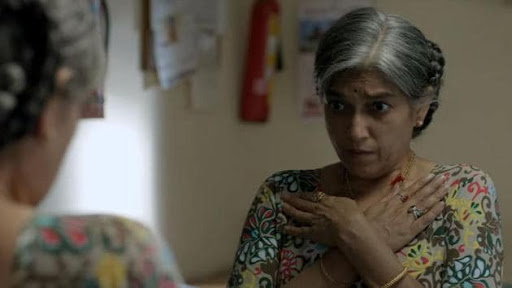
And CUT!...the sex? Sunflowers and Censorship in Indian Media
Media in India is a complex being. Cinema is one of the eminent soft powers India has, as the world knows us by our over-the-top dance numbers, colorful sequences, and cheesy storylines. Over the past years, there has been a subtle yet profound shift in the content of cinemas. The best films often make us forget that we are in the theaters. It makes us cry and laugh with the character, to live through them. So, how does one feel, when their freedom of self-expression is censored? Or their needs and wants are deemed “too western” and “not in line with our sanskaras”?

Censor Board and India
The Cinematograph Act of 1952 offered more “principles for guidance in certifying films”. In terms of sexual contact, if a film was against the interests of “decency or morality” then it would not be given a certificate and therefore couldn’t be shown. But who gets to decide what is “decent” or “moral”? Sex scenes started to be shown instead of the heroine dancing in wet sarees, and sunflowers being rubbed together? Maybe you will never watch a fountain in the park with sunflowers in the same way again.
India topped in 2017 on the list of “Countries which banned the most number of films” according to a study by The State of Artistic Freedom by Freemuse, an independent international organization advocating for free artistic expression.
According to the study, 67% of all documented cases were against films and filmmakers in India. 50% of all recorded violations were censorship cases of which 86% of censorship cases were against cinema. 91% of all documented violations were by government authorities (55%) and nonstate actors (36%), including religious and caste groups. India’s problem with censorship of films can be encapsulated in two basic attitudinal hurdles — fear and a lack of ‘put your money where your mouth is’.
Even on OTT platforms like Netflix and Amazon Prime, the government has issued several notices in the past couple of years to censor the usage of abusive language and sexually explicit content. The key factor in Indian media is its packaging to the family- the film should be universally appealing to EVERYONE- Baba, Maa, Beti, Beta, Grandpa and Grandma, even your neighbors. This logic can be seen rampant when all topics of action, masala romance, and “sanskar values” of the family unit get shoved into one script, interspersed with the sensual touch of the heroine’s sleeveless arms.

Ageism, Intersectionality on the Bada Parda
The biggest hurdles many senior citizens face, when the topic of love and sexuality comes in, is from their children. As I was watching LUMB, I realized how conditioned we are to feel that silver-gray hair indicates the expiry date on sex, as I initially felt my cheeks heating up in the swimming pool scene of Bua holding the instructor. How can at this age of creaking bones and wrinkles can you think of lust? It is scandalous to even think about our grandparents ever sleeping together, and yet that is one of the most basic needs of all. It is a double whammy for our censor board, where the objections were centered around the portrayal of homosexuality and also the sexuality of women. The sexuality of women is a taboo subject, which is not even seen as being important, which was observed during the outrage against LUMB and other films like Unfreedom, Fire, Loev, etc.
Even for Margarita with a Straw, the directors had to cut the scene of the two girlfriends kissing, which aptly depicts the Indian media’s take on queer representation. While changing attitudes within our government and the public may be a long-term process, urgent reform of the CBFC Board of Directors is essential.
While watching LUMB and MWAS, I loved how flawed the characters were, and how they dared to hope. The films contain very unconventional yet relatable women characters, with the tragedy of patriarchy and other issues, and yet they have this innocence and curiosity regarding love and sexuality, just like the rest of us.
Changing the age of certification and the effort to have filmmakers and industry voice command boards are critical changes that need to be implemented as soon as possible. We can then slowly begin to push the boundaries of what is acceptable by realizing that we have an Indian audience mature enough to handle truth and fiction while understanding the difference between the two. Once we accept it, we can escape the culture of “prohibition” that has quickly made us the laughing stock and misery of the world

CONCLUSION
Relating a person to the whole world: that is the meaning of cinema.” ~ Andrei Tarkovsky
From finding love and exploring our sexuality in our second innings to finding love as a person with a disability, living life like we want, shouldn’t be limited to just heteronormative couples who fit the bill of a traditional family under patriarchy. And hence, to normalize these plethoras of depth and variety existing in our daily lives, to depict them on the silver screen.
Movies like “Lipstick under my Burkha” and “Margarita with a Straw” pushes the envelope of what it means to sneak out a bit under the heavy blanket of the “normal” and when watching these flawed characters on screen crave for love, sex, and affection, we can’t help but either “awww” or cringe. And yet we see ourselves in them, in their struggles, in their hope. And censoring such depictions infringes on our right to be ourselves: the ultimate form of freedom.
Certificate boards should exist to categorize films for easy viewing, after all, the watchers want to sort out which films are kid-friendly or not. But censorship in this century needs to be rethought, if not completely removed from the Indian cine scene.
Author


1 thought on “And CUT!…the sex? Sunflowers and Censorship in Indian Media”
nice article